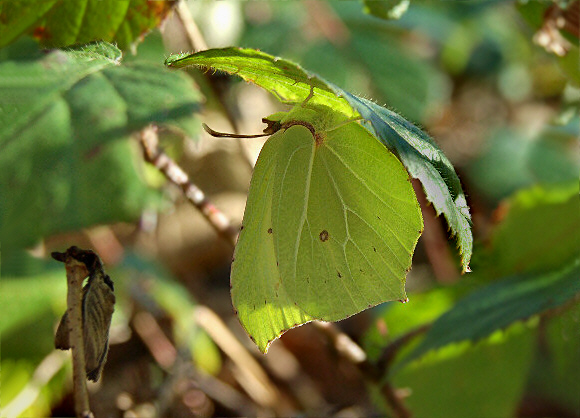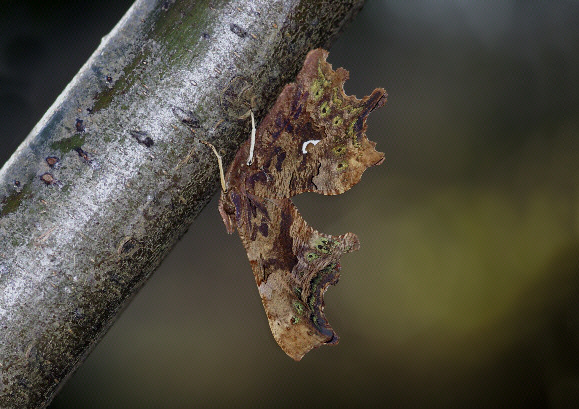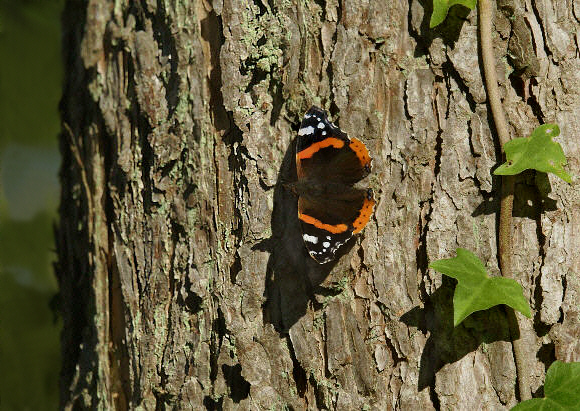Butterflies are cold-blooded. If they get too cold they cannot fly, and if the weather is too hot and dry they become dehydrated and die. Consequently during times of extreme heat, cold or drought they have to enter a state of diapause – a condition in which the metabolism is extremely low, and normal activities such as flying, feeding and breeding are suspended.
Hibernation
Hibernation is a process that depresses metabolism and energy consumption during the cold winter months. It ensures that energy is not wasted on fruitless searches for nectar and foliage in winter, and synchronises the spring reawakening with the time when flowers and fresh foliage reappear.
In temperate regions of the world most butterfly species overwinter as larvae. Others hibernate as eggs or pupae. A small number, including Inachis io, Polygonia c-album and Gonepteryx rhamni overwinter instead as adult butterflies.
To successfully overwinter they need to find a place to hide where they are protected from the worst of the wind, rain and snow. They may be in diapause for several months, and throughout this period they must remain undetected by birds.
Accordingly they have evolved cryptic colours, patterns and unusual wing shapes that combine to provide them with effective camouflage. The Brimstone Gonepteryx rhamni for example hibernates under bramble or ivy leaves and has wings coloured to match winter foliage. Its wings are also leaf-like in shape and have raised venation to simulate the veins of real leaves.
 Gonepteryx rhamni hibernating beneath a bramble leaf, West Sussex, England – Adrian Hoskins
Gonepteryx rhamni hibernating beneath a bramble leaf, West Sussex, England – Adrian Hoskins
Many overwintering species such as the Peacock Inachis io, Camberwell Beauty Nymphalis antiopa and Large Tortoiseshell Nymphalis polychloros hibernate beneath logs or in hollow tree trunks; or in other dark places such as caves or animal burrows. These species have evolved very dark ventral wing patterns which make it difficult for foraging birds to locate them in their gloomy surroundings.
A few species such as the Comma Polygonia c-album hibernate openly, hanging from tree branches or amongst piles of leaf litter on the forest floor. Their dark marbled patterns and strange angular wing shape provides them with an extremely effective dead-leaf disguise.
 Polygonia c-album, hibernating beneath a branch, West Sussex, England – Adrian Hoskins
Polygonia c-album, hibernating beneath a branch, West Sussex, England – Adrian Hoskins
The Red Admiral Vanessa atalanta is a species that doesn’t hibernate in the true sense of the word. On cold wet winter days it hangs motionless from branches, but awakens whenever the weather is warm enough for activity. It can often be seen basking on tree trunks on sunny mid-winter days.
The butterfly gets sustenance from winter berries, tree sap, dung and mineralised moisture on the ground. It continues to breed throughout the winter months, laying eggs on Urtica stinging nettles. In harsh winters the resulting caterpillars perish, but in milder winters a few manage to survive and pupate, producing newly emerged adults in February or early March.
 Red Admiral Vanessa atalanta on pine trunk in mid-winter, West Sussex, England – Adrian Hoskins
Red Admiral Vanessa atalanta on pine trunk in mid-winter, West Sussex, England – Adrian Hoskins
Another species which overwinters in a state of semi-hibernation is the Monarch Danaus plexippus which gathers in tens of millions each winter, cloaking the trunks of pine trees in the mountains of Mexico. Monarchs are not protected by the “anti-freeze” that prevent the true hibernating species from freezing solid.
They stay alive by periodically shivering their wings, thereby generating heat by friction. Often the butterflies are dislodged from the tree trunks by winds or foraging birds and fall to the ground. Upon landing they are too cold and weak to move so they shiver their wings just sufficiently to raise their temperature enough to enable them to crawl or fly back up onto the tree.
Aestivation
Butterflies need to maintain their body temperatures within operational limits. They quickly become dehydrated if conditions become too hot. Consequently they cool themselves by seeking shade or by drinking water from puddles or the edges of streams. There are times however when even these measures are insufficient to prevent desiccation.
In many tropical regions such as India, Australia, east Africa and Amazonia the dry season can be extremely hot and dry, making it impossible for butterflies to go about their normal activities. Their nectar sources and larval foodplants shrivel and die. Sources of moisture become very scarce. To avoid death in such circumstances butterflies have only two choices. They must either migrate or they must go into a state of diapause. Summer diapause is known as aestivation.
Butterflies in the families Pieridae, Papilionidae and Hesperiidae normally escape the ravages of the dry season by migrating to lusher environments. Members of the Nymphalidae, especially the tribes Ithomiini, Heliconiini, Brassolini, Danaini and Satyrini usually stay put however and seek moist dark places where they can hide away during the arid mid-summer months.
Some South American species e.g. Marpesia berania roost communally in densely packed clusters of 60 or more adults, hanging from branches. Others including Danaus misippus and Euploea core from south-east Asia, and various Heliconius species in South America, congregate in loose groups of between 6-30, hanging from dry twigs.
Ithomiines such as Methona, Melinaea and Mechanitis tend to aggregate at dried out river beds in deeply shaded areas within the forest where they hide away amidst tangles of palm rootlets. They periodically awake from their slumber to imbibe organic fluids from nearby plants, which help them to replenish their dwindling lipids. Mostly however they remain hidden within their rootlet shelters, until such time as the first rains of the wet season stimulate them to seek mates and reproduce.
